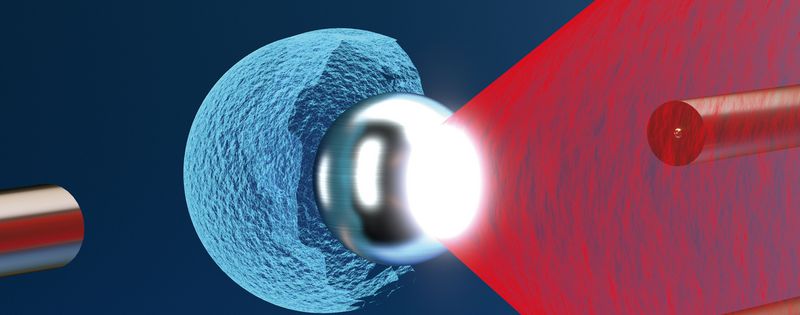featured publications – Light, when strongly concentrated, develops an enormous power. Using this concentrated energy, a team of physicists from the Institute of Experimental Physics — Medical Physics at the cluster of excellence the Munich-Centre for Advanced Photonics (MAP) of Ludwig-Maximilians-Universität München caused an explosion. The researchers concentrate laser light onto beads of plastic just a few micrometers in size. The concentrated energy blows up the nanoparticles. This releases radiation made up of positively charged atoms (protons). Such proton beams could be used in future for treating tumors, and in advanced imaging techniques.
When sunlight hits our skin, we feel warmth. One can imagine the energy this radiation would hold were it to be concentrated. At Texas Petawatt Lasers in Austin, Texas, physicists from the Institute of Experimental Physics — Medical Physics of the cluster of excellence MAP concentrated laser light so strongly on plastic nanobeads that these essentially exploded. In the experiment, approximately one quadrillion billion photons (3 times 1020 photons) were focused onto microspheres of about 500 nanometers in diameter. These plastic beads consist of about 50 billion carbon and hydrogen atoms and are fixed in a floating position by the electromagnetic fields of a so-called »Paul trap«, whereby the laser beam can irradiate them.
The remaining, positively charged atomic nuclei are then violently repelled, and the nanospheres explode at speeds of around 10% the speed of light. The radiation from the positively charged atoms (protons) then spreads out in all directions.
This production of proton beams with laser light promises new paths in nuclear medicine: for example, in the fight against tumors. At present, proton beams are produced by conventional accelerators. In contrast, laser-generated proton beams open the door to the development of novel — perhaps even cheaper and more efficient — methods of treatment. The Munich-based team, led by Prof. Jörg Schreiber, generally produces proton radiation using a diamond-like film, onto which extremely strong laser light is then beamed. Proton radiation is thus emitted, which could then be applied to the body via an external source.
The production of radiation through the explosion of plastic nanobeads might even allow for the possibility that nanoparticles could be placed inside a tumor, and exploded with laser light. Thus proton beams could be put to work in destroying tumors without causing damage to surrounding healthy tissue.
